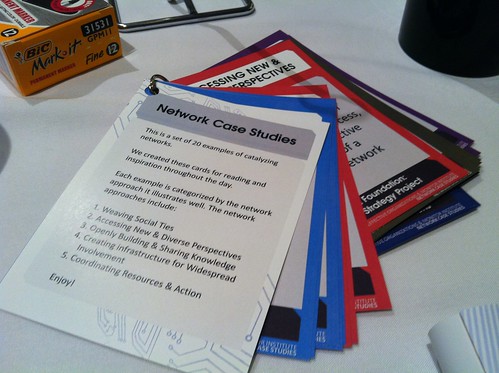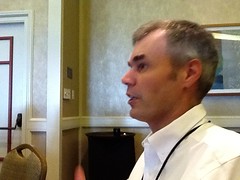
Note from Beth: Since the concept of working in Networks is can be hard to explain to newcomers, learning from case studies, stories, and examples can be illuminating. The design was to share this learning was amazing. In the morning, each of the ten case study presenters gave a 5 minute “teaser” about their case study or what one presenter called “showing a little leg.” After lunch, conference participants got to to choose two presenters to spend an hour with in a small group to ask questions and deepened the learning. I was attracted to this discussion about the Boston Youth Sports Initiative hosted by Roberto Cremonini and Chris Lunch because we explored the “So, What?” question and curated the key points tweeted about it on Storify here. Annie Hernandez wrote up the report below.

The Story of the Sports Initiative Network, Guest post from Annie Hernandez
This is a summary of my notes and take-aways from the small group discussion on the Boston Youth Sports Initiative with Roberto Cremonini with Cremonini Consulting (formerly with Barr Foundation, funder of project) and Chris Lynch with Squash Busters (formerly with the Initiative).
The Barr Foundation identified that there were disparities in youth sports especially as it relates to opportunities for girls. The goal for Barr was to get more kids involved in sports programming. They chose to explore networks as the approach towards a solution.
They hired a network weaver and spent the first months talking to people about what kept them up at night and introducing the network concept. The message was that the network was open to everyone. Members of the network can take advantage of whatever makes sense for their organization–like a cafeteria model. The Foundation provided money for small, easy projects for quick wins and supported convenings of the group.
As Chris shared, “You need to get people together and talking and then find commonalities. My role was to connect those dots and build trust in the network.”
One of the quick wins was to help the organizations with logic models/outcome work which helped them secure additional funds as well as learn together.

It was also important in the beginning to address for each person what’s in it for them. One strategy they employed was a newsletter that had a “craigslist” feel. This built good will through the sharing and made members feel like someone was looking out for them. The more organizations that participated the more value they saw.
As the effort grew, it was hard to capture the outcomes and report them…as they didn’t always know the connections. As Chris shared, “Logic models don’t work for networks because of their emergent nature. Getting to behavior change takes time.”
It was important to be less selective of who was invited to the network at the beginning. Their advice was to figure out who supports network behavior and involve/dance with them. Get one third of the prospective members involved and the next third will follow. There cannot be a deadline for application for networks–people should enter at whatever point feels natural; the door is never closed; once a member always a part of the network.
The value of the network weaver is that they have deep knowledge in the field. They have to be seen and build authentic relationships to be perceived as more than just money. A good use of network weaver money was with grassroots all volunteer groups–the weaver helped develop these clusters. They found value in balancing both program and network/ capacity support.
Leadership changes in staff and key volunteers changes the network and has ripple effects. Network weavers need to build on this opportunity.
The initiative has sunsetted with the loss of foundation funding after 7 years. The lasting impacts of the Initiative include:
– for Barr: it helped develop the network mindset of the program staff
– for the participating organizations: they created lasting relationships that people still leverage to make things happen; some intermediaries have picked up programs and the newsletter continues.
– Goal: kids can access the sports more readily.
With this sunsetting, they offered a number of learnings or recommendations:
– one strategy to get a weaver out of the hub is to build more and more mini-weavers who have the same relationships. The weaver needs to close triangles early and often–and get out of the middle.
– if a foundation starts a network, the need to help build relationships with other foundations. They fall into the funding issues then of other intermediaries not wanting to compete with it’s members for funds.
– think of a Leadership or steering committee as network guardians and embed them in the network.
– Shift the power differential by getting foundation boards and nonprofits in this conversation.
– Foundations need to support transitions when sunsetting which should include the production of learning documents and celebrate the successes with the network and communicate what is happening.
Final thought: This work is a leap of faith–you may not know this will make a difference at the beginning.
Budget for project: $250,000 annually for three years was last grant.
Annie Hernandez is Program Officer Organization & Leadership Development for the Lumpkin Family Foundation.
goodWORKSconnect.org
annie@lumpkinfoundation.org

Leave a Reply